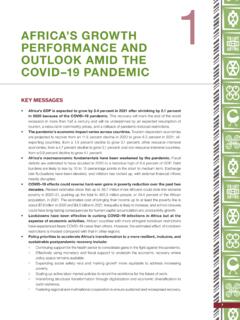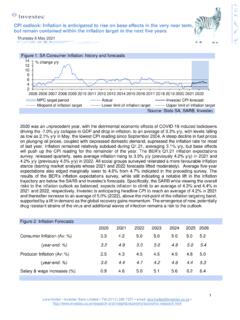Transcription of Reviving India’s growth - pwc
1 1 PwC | Reviving India s growth | Union Budget 2021 22 Reviving India s growthUnion Budget 2021 22 February 20212 PwC | Reviving India s growth | Union Budget 2021 22 ContentsKey highlights01 economic outlook02 Key tax and regulatory proposals04 Key sector announcements033 PwC | Reviving India s growth | Union Budget 2021 22 economic recovery through investment, self-reliance and inclusivenessKey announcementsJob creation through private and public investment by way of an infrastructure boost; set-up of textile parks, fishing hubs and a financial services hub; an increase in the FDI limit in the insurance sector; allowing one person companies to help start-ups; and allowing women in all categories of jobs and boost to health and well-being with a 137% increase in Budget allocation for the sectors, launch of PM Aatmanirbhar Swasth Bharat Yojana and Mission Poshan , allocation of INR 350 billion for COVID-19 vaccines, and expansion of the health information portal to connect all public health labs across all states and union to MSMEs by doubling allocation for the Ministry of Micro, Small and Medium Enterprises to INR 157 access to credit through setting up of a new asset reconstruction company and asset management company to take over stressed assets of banks, setting up of a Development Finance Institution to finance infrastructure projects and equity infusion of INR 200 billion for public sector ease of doing business by setting up of a conciliatory mechanism for quick resolution of contractual disputes, strengthening of the NCLT system, adoption of e-courts, setting up of an alternative mechanism of debt resolution.
2 Decriminalising of the Limited Liability Partnership (LLP) Act, setting up of a faceless dispute resolution mechanism for small taxpayers and increase in the threshold for tax audit from INR 50 million to INR 100 highlights4 PwC | Reviving India s growth | Union Budget 2021 22 Global economyAs per the IMF s World economic outlook update (January 2021), while global growth is estimated to decline by in 2020, it is expected to rise by in 2021. Based on strong policy support and expectations of an early roll-out of vaccines, advanced economies are likely to grow by in 2021. Though emerging economies are likely to witness varied recovery paths, on average, they are expected to grow by in 2021 on the back of a contracted economy1 India was already experiencing economic headwinds before the pandemic, with GDP registering 4% growth in FY20. With the onset of the pandemic and lockdown restrictions on economic activity, GDP growth for FY21 is estimated to decline by Private consumption is estimated to contract by in FY21 owing to demand shrinkage based on income loss, mobility restrictions and supply constraints.
3 Government consumption is estimated to rise by due to increased expenditure as part of pandemic relief packages. Investment is estimated to decline by due to economic uncertainty and delays in the implementation of capital agriculture sector is estimated to grow at in FY21, mainly due to early relaxation of lockdown restrictions for farming activities, a good monsoon, efficient procurement of foodgrains and an increase in kharif and rabi acreage. The manufacturing sector, however, is expected to decline by during FY21 owing to weakness in domestic and global demand, temporary closure of production units during the lockdown and supply constraints. The service sector is also estimated to decline by in FY21, primarily due to mobility restrictions, low demand for contact services, and deferment of discretionary expenditure by outlookConsumption indicators indicate demand recovery in Q3, including FMCG and auto sales, and GST collection. Sectors like health, pharma, technology (e-commerce, FinTech, EdTech, etc.)
4 And telecom have shown growth potential during the pandemic and are likely to witness increased investment and robust growth in the future too. The pandemic has led to a higher preference for digital services and online transactions, thus promoting digitalisation in many companies. Further, companies are investing in improving their supply chains and distribution networks to overcome supply challenges and risks that came to light with the COVID-19 disruption. economic outlookFigure 1: GDP growth ratesSource: World economic outlook (January 2021); IMF(Note: Data for India is presented on a fiscal year basis; all other data is on a calendar year basis.) outputAdvanced economiesEMDEsIndia20192020 (Estimate)2021 (Projection)Figure 2: Annual GDP growth and demand components at constant pricesSource: Data till FY20 is taken from the first revised estimates of GDP (dated 29 Jan 2021); growth rates for FY21 are taken from the first advance estimates of GDP (dated 7 Jan 2021). (RE)FY21(AE) consumptionGDPI nvestmentGovt.
5 Consumption1 GDP and sectoral growth rates quoted in this section for FY21 are taken from the first advance estimates of GDP released by the National Statistical Office, Ministry of Statistics and Programme Implementation (MoSPI).4 PwC | Reviving India s growth | Union Budget 2021 225 PwC | Reviving India s growth | Union Budget 2021 22 Fiscal positionAs per revised estimates, the fiscal deficit is estimated to be of the GDP for FY21, which is higher than the budgeted for the year based on revenue contraction and increased Government expenditure for COVID relief. For FY22, the Government has budgeted the fiscal deficit to be of the GDP based on improvement in revenue collection, expenditure on vaccine roll-out and capital expenditure. The Government plans to reduce the fiscal deficit subsequently to by FY26. This indicates that the fiscal stimulus is expected to continue over the next three financial years towards supporting growth in the post-pandemic Government has budgeted an increase of in net tax revenue and in non-tax revenue as compared to FY21 RE.
6 Disinvestment receipts are budgeted to be INR trillion in FY22. Further, an increase of has been budgeted for revenue expenditure and for capital expenditure for FY22, as compared to FY21 BE. Sectors that will receive higher allocation in FY22 as compared to the FY21 budget include finance, transport, rural development, commerce and industries, and urban development. Sectors that will receive lower allocation compared to last year s budget include planning and statistics, IT and telecom, education and social outstanding liabilities of the Central Government are expected to increase by 12% in FY22 to INR trillion as compared to INR trillion at the end FY21. Interest payments are expected to rise by 17% in FY22 as compared to FY21 RE. Interest payments as a percentage of revenue receipts are expected to increase from in FY20 to in FY21 RE and in FY22 3: growth rate for sectoral gross value added Source: Data till FY20 is taken from the first revised estimates of GDP (dated 29 Jan 2021); growth rates for FY21 are taken from the first advance estimates of GDP (dated 7 Jan 2021).
7 AgricultureManufacturingConstructionServ icesFY19FY20 (RE)FY21 (AE) rate for sectoral RE2021-22 BEReceipts of Central GovernmentINR trillionCentre s NetTax receipts(Net) expenditure and compositionINR trillion2018-192019-202020-21 RE2021-22 expenditureCapital expenditureTotal expenditureFiscal deficit2018 192019 202020 212021 22 ProjectionsBudget 2019 2020 by 2022 23 Budget 2021 by 2025 26 Based on prospects of robust growth in consumption and investment and a lower base effect, GDP is estimated to grow at 11% in FY22 as per the economic Survey 2020 21. However, there are several risks that require attention. The key downside risks emanate from inflation with upward pressure on prices due to rising input cost, oil prices, unemployment, increasing non-performing assets of banks, rising yields and a likely recurrence of taper tantrums when the tightening of global monetary policy PwC | Reviving India s growth | Union Budget 2021 22 Background The overall spend of the healthcare sector is around of the GDP, with the Government spending around The Government intends to increase its spending to around of the GDP by 2025.
8 The country was already coping with the dual burden of communicable and non-communicable diseases. The pandemic has added another, and India is now dealing with a triple disease burden. While the COVID pandemic tested India s physical healthcare infrastructure, it led to accelerated adoption of digital health (online consultation, increased usage of digital platforms like telemedicine and e-pharmacies) and home health services. It also led to elective procedures being postponed, which had an impact on hospital operations and led to fewer consultations and health check-ups. This in turn has impacted the overall health and well-being of the population. At the same time, the Government has announced the Production Linked Incentive (PLI) scheme for the active pharmaceutical ingredient (API) industry. This scheme is in line with the theme of building an Aatmanirbhar Bharat (self-reliant India) and could provide a boost to India s pharmaceutical sector, which is the third largest provider of generic drugs globally by volume and supplies over 50% of the global demand for various vaccines, around 40% of generic demand in the US and around 25% of all medicine in the UK.
9 The industry expected Budget 2021 to increase the overall spending on healthcare for building better capability and capacity to tackle the triple burden of disease and to incentivise the private sector via benefits or building new healthcare capacity. At the same time, it expected a greater impetus for strengthening R&D in pharma and life sciences companies. It was also expected that the Government should monitor the effectiveness of the PLI scheme and revisit incentives such as technology upgradation fund or capital subsidies for medical equipment, tax holidays and other incentives for manufacturing medical devices in industriesKey sector announcementsKey announcements Health and wellness is an important pillar of this budget. Investment on health infrastructure has increased substantially. The total budget outlay for healthcare is INR lakh crore, which is an increase of 137% from last year s budget of INR 94,000 crore. The New PM Atmanirbhar Swasth Bharat Yojana is to be launched with an outlay of INR 64,180 crore over six years.
10 This is to build capacities in primary, secondary and tertiary care. This is in addition to the amount budgeted for the National Health Mission An additional INR 35,000 crore has been allocated for COVID-19 vaccines. The Government is committed to spend more on this front if needed. India has two vaccines against Covid-19 and two more are on the way. The Government proposes to introduce the National Nursing and Midwifery Bill as well as the National Commission for Allied and Healthcare Professionals Bill. Pneumococcal vaccines will be rolled out across the country. This will prevent over 50,000 child deaths annually. The Supplementary Nutrition Programme and the Poshan Abhiyan are to be merged into Mission Poshan to strengthen the nutritional content, delivery, outreach, and outcome of nutrition programmes. The outlay for the PLI scheme for manufacturing will be increased over the next five years. Innovation and R&D is another important pillar of the budget. A total of INR 50,000 crore has been allocated over five years to strengthen the research ecosystem.














